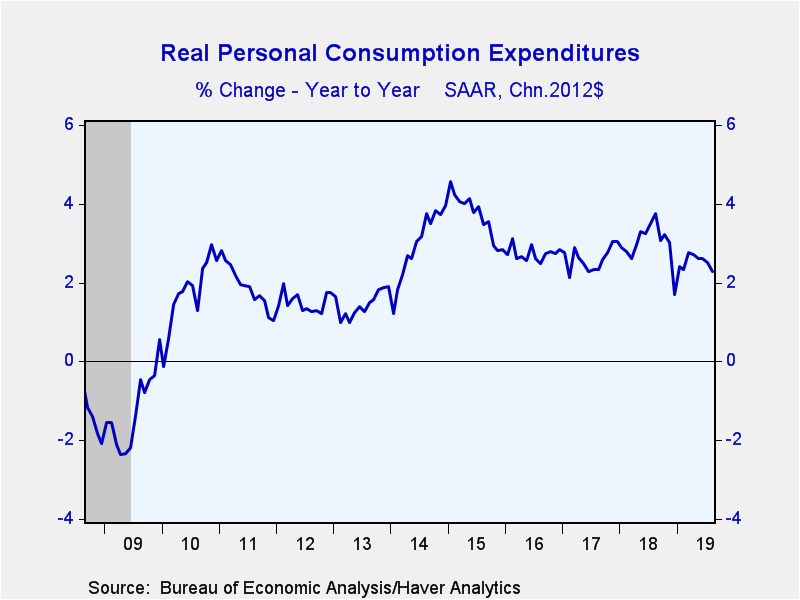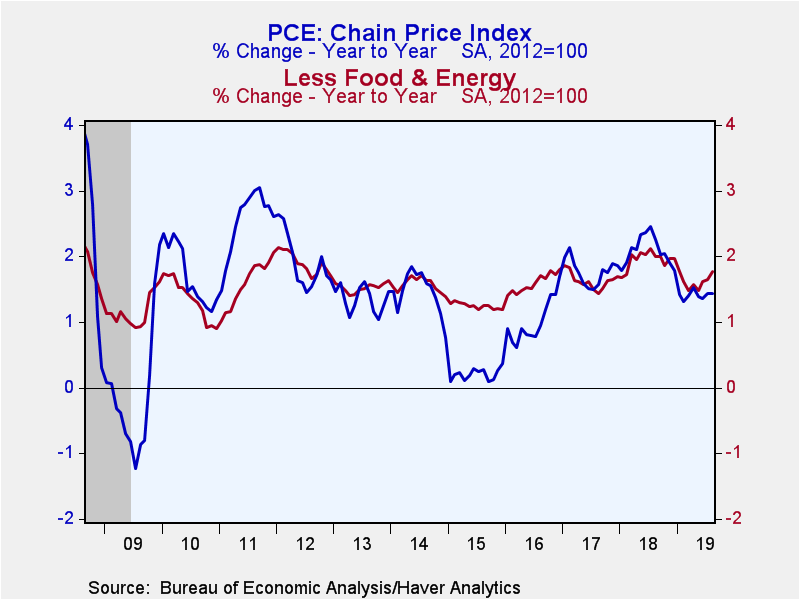 Global| Sep 27 2019
Global| Sep 27 2019U.S. Personal Spending Unexpectedly Slows as Income Improves
by:Tom Moeller
|in:Economy in Brief
Summary
Consumers exhibited caution last month despite strength in earnings. Personal consumption expenditures edged 0.1% higher (3.7% y/y) during August following a 0.5% July rise, revised from 0.6%. A 0.3% gain had been expected in the [...]
Consumers exhibited caution last month despite strength in earnings. Personal consumption expenditures edged 0.1% higher (3.7% y/y) during August following a 0.5% July rise, revised from 0.6%. A 0.3% gain had been expected in the Action Economics Forecast Survey. In constant dollars, spending also rose 0.1% (2.3% y/y), the weakest rise in six months. It was held back by zero change (1.4% y/y) in real services outlays, following 0.1% gains for two straight months. Spending was held in check by a 0.8% decline (+0.1% y/y) in real outlays at restaurants & hotels. It also was restrained in most other service categories. Constant dollar recreation services outlays held steady (1.6% y/y) after declining 1.0% in July. Real housing & utilities demand also was unchanged (0.9% y/y) and expenditures on transportation services edged 0.1% (2.2% y/y) higher. Showing strength were real health care services outlays which rose 0.4% (2.2% y/y), the quickest monthly rise since March. Real outlays on nondurable goods also were soft as they rose 0.1% (3.6% y/y), held back by a 0.7% decline (+1.9% y/y) in apparel buying. Spending on the volume of gasoline & oil also fell 0.4% both m/m and y/y. Food & beverage expenditures rose 0.2% (3.0% y/y) in real terms. These restraints on spending contrasted with a 0.9% jump (5.6% y/y) in real outlays on durable goods. The strength was led by a 1.1% surge (3.0% y/y) in real furniture & appliance outlays which followed a 0.9% gain. Constant dollar spending on recreational goods & vehicles rose 1.0% (12.5% y/y) following a 2.5% July improvement, and motor vehicle & parts spending increased 0.7% (1.9% y/y) when adjusted for price inflation after falling 1.0% in July.
Personal income improved 0.4% (4.6% y/y) for the fifth time in the last six months. Wages & salaries surged 0.6% (5.3 y/y) after a 0.2% rise. Proprietors income also strengthened 0.6% (4.1% y/y) for a second straight month. Rental income gained 0.2% (2.5% y/y), the same as in July, but receipts on assets eased 0.2% (+1.3% y/y), off for a second consecutive month. Transfer receipts improved 0.3% (7.0% y/y), the same as during the prior month. Personal disposable income rose 0.5% in August, the largest gain in twelve months. Adjusted for inflation take-home pay rose 0.4% (3.0% y/y) after stability in July. It also was the largest increase since February.
Last month's strength in income relative to the gain in spending pulled the personal savings rate up to 8.1%. That recouped the decline in July, but kept it below the 8.5% averaged in Q1 of this year. The level of personal saving rose 13.0% y/y in July.
Price inflation as measured by the PCE chain price index was steady in August (1.4% y/y) after a 0.2% rise. The price index excluding food & energy edged 0.1% higher, but the y/y increase strengthened to 1.8% from the low of 1.5% in March. It was the largest y/y increase in core prices since January. Energy prices eased 2.0% (-4.4% y/y) in August while food prices fell 0.2% (+0.8% y/y).
The personal income and consumption figures are available in Haver's USECON database with detail in the USNA database. The Action Economics figures are in the AS1REPNA database
Tom Moeller
AuthorMore in Author Profile »Prior to joining Haver Analytics in 2000, Mr. Moeller worked as the Economist at Chancellor Capital Management from 1985 to 1999. There, he developed comprehensive economic forecasts and interpreted economic data for equity and fixed income portfolio managers. Also at Chancellor, Mr. Moeller worked as an equity analyst and was responsible for researching and rating companies in the economically sensitive automobile and housing industries for investment in Chancellor’s equity portfolio. Prior to joining Chancellor, Mr. Moeller was an Economist at Citibank from 1979 to 1984. He also analyzed pricing behavior in the metals industry for the Council on Wage and Price Stability in Washington, D.C. In 1999, Mr. Moeller received the award for most accurate forecast from the Forecasters' Club of New York. From 1990 to 1992 he was President of the New York Association for Business Economists. Mr. Moeller earned an M.B.A. in Finance from Fordham University, where he graduated in 1987. He holds a Bachelor of Arts in Economics from George Washington University.










